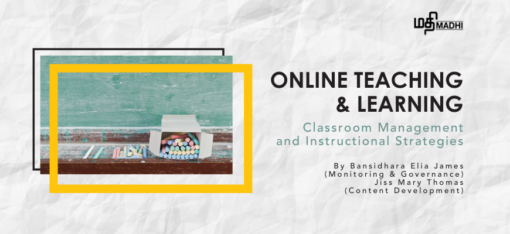
Online Teaching and Learning: Classroom Management and Instructional Strategies
The pandemic has led to the abrupt closure of schools and has left millions of teachers and students in a lurch regarding continuing education. In order to bridge the gap of teaching and learning, the entire world seems to have turned to online/blended learning modes. While it has become a norm and a necessity, millions of teachers have been pushed into uncharted territory with little or no training. If you are a teacher and have figured out a way to navigate through the technical challenges, and are thinking about classroom management and improving your online instruction, this blog is for you.
Recently, I had the privilege to conduct an online teacher training workshop for about 100 enthusiastic teachers through Teacher Champ – a COVID response project conducted by Madhi Foundation. The execution of the course led to research on the differences between online and face to face classes. Having had the experience of teaching in a classroom for 2 years, the idea of an online class seemed somehow strange and scary. I am sure a lot of teachers out there feel the same. But here is some good news, the research points that the similarities outweigh the differences between the two modes of teaching. In this blog, I will summarise the comparison between the two and dive into classroom management and instructional strategies that work well in both online and face to face classrooms.
Whether over a computer or in a classroom, every day of teaching remains an adventure! I’m sure a lot of teachers will agree with this statement. Even as the points laid out above assure us that there are many similarities between the two modes of teaching, it is a challenging undertaking to teach without the physical presence of students. There are, therefore, some principles we need to follow to set up a good online class:
Strive for presence: social, cognitive, and teaching presence.
Interactivity is the heart and soul of effective asynchronous/online learning.
Let the students do (most of) the work. The more time students spend engaged with the content, the more they will learn.
Does it sound familiar to face to face teaching? I thought so too. With conscious effort, a teacher can build their online teacher presence and interact with the students without needing to be loud or being physically present. All the three principles are not to be seen in isolation but must instead be employed as a means to improve student learning outcomes in entirety.
Let us look at 8 classroom management and 9 instructional strategies that will help you establish a strong teaching and learning environment for the students.
Here are 8 Classroom Management Strategies
This refers to the wide variety of skills and techniques that teachers use to keep students organised, orderly, focused, attentive, on task, and academically productive during a class.
1. Establish Norms
It’s important to establish clear rules and expectations regarding student discipline, participation, the study process, deadlines, etc. To do so and build accountability, encourage all students to help you build classroom rules and reason out with students the need for such a rule while making norms.
For example, rules can be such as:
Check in with your teacher. Gather your materials
Be on time
Stay engaged (nod or thumbs up) if others are talking
Mute your mic if you are not speaking
2. Establish a Routine
Students feel more confident and comfortable when the study process is well established and the procedures are predictable.
For example, a typical routine for study hour could include instructions like the following:
Set a schedule and stick to it
Meditate for 5 minutes
Share one good thing about the day
3. Clear Instructions
The teacher needs to give clear instructions at the beginning of every task, for the student to engage in an activity with clarity and manage time efficiently.
For example, the following image shows the detailed instructions that could accompany a simple writing activity.
4. Positive Reinforcement
Teachers could observe the students who follow the instructions and expectations set in the classroom and acknowledge their efforts. Another way to appreciate the students is by writing positive individual messages and by making phone calls. These techniques will not only encourage student participation but can also help in building a stronger relationship between the students and teachers.
For example, the teacher can say encouraging messages such as:
“I saw how you were helping other kids. I’m so proud of you”
“I like how Suresh is answering questions, I want others to also answer.”
“Thank you, Kanniammal for sending your homework.”
5. Call and Response
To regroup the students or get the attention of the students, a teacher can use the Call and Response technique. Teachers can say aloud the first part of a phrase and the students should immediately look at the teacher and say the second part of the phrase. Please note that it Is not necessary to turn on the audio of your virtual classroom as that might create chaos.
For example, the teacher can establish a ‘call and response’ routine where when the teacher says ‘One Two’, the students respond loudly with ‘Eyes on You!’.
6. Energiser
Energisers help regain students’ attention, take a brain break and prepare them for the next task.
For example, rhythmic clapping, following dance videos, etc. are great energisers.
7. Count Down
Teachers can use a countdown to help children re-group after an activity/discussion.
For example, the teacher can count backwards from 5 to 1 to get the students’ attention.
8. Hand Signals
Teachers and students can co-decide hand signals to make a discussion purposeful and engaging.
This video shows some useful hand signals that teachers can incorporate in their classrooms.
Here are 9 Instructional Strategies
Instructional strategies are learning techniques a teacher can use to help students learn or gain a better understanding. It allows teachers to make the learning experience more fun and practical and encourages students to take more of an active role in their learning.
1. Check for understanding
Teachers can ask questions after teaching a concept to see if the students have understood it. These questions can be thinking questions or direct questions from the concept.
Correct Example: “What are the two types of ….?”
Wrong Example: “Did you understand?”
2. Tell me what to do
The teacher can also check if students have understood the instruction by making the students repeat what was just told to them.
3. You can answer
If a teacher finds that a student is not able to answer, he/she can ask another student to say the answer loudly. The teacher can repeat the question to the first student and encourage them to repeat the answer. This helps the students develop a sense of community and inclusion because of the opportunity presented to them.
4. Graphic Organizer
This is an important tool that allows students to visually categorize new information or review old information. It helps to conceptualize the information given to them during the class. When students look at the information that’s organized, it’s easier for them to retain and remember that information.
For example, simple flow charts like this or this with boxes and arrows do a marvellous job of communicating structured information that a paragraph of text may not be able to.
5. Gamification
We can also use games to make online learning fun and engaging. Games can be used to make assessments and classroom interaction more interesting. It is important to align the gamified elements with learning objectives. You can incorporate gamified elements such as points, levels, badges and leaderboards.
Some tools for gamification are Kahoot, Quizizz, Khan Academy and Microsoft Math Solver.
6. Continuous Assessment and Feedback
Having continuous short assessments can help teachers gauge the students’ progress and keep the student motivated. These assessments need not be lengthy and can entail just asking 5 questions relating to the concept. It will help the teachers decide the next steps for the learning outcome/concept.
7. Cold Call
In order to make participation the expectation, call on students regardless of whether they raised their hands to answer a question. This will encourage students to always be attentive in the class and will provide equal opportunity to all students to participate in discussions.
For example, the teacher can write down the names of each student on one ice cream stick or a piece of paper each, and show the names on the video to call on individual students and check their understanding.
8. Word Drill
Select a word wall from the textbook and do a drill every day. This can be a routine for your class. If there is no word wall available in the syllabus textbooks, you can use Dolch sight words, CVC words or curated wordlists from the syllabus textbooks.
9. Spell Check
Give five words every day as homework and ask the students to learn the spellings. You can conduct a spell check for the students regularly. This can be followed for all the subjects.
I hope these strategies will help you take an online class. As a teacher myself I would recommend using 1 or 2 strategies consistently for 8 weeks and then add or change them accordingly. It also helps to make a conscious choice to use these techniques regularly, as many teachers might be new to these strategies.
Let us make learning possible even when it is difficult and seems impossible!
Works Cited
McAleavy, T., & Gorgen, K. (2020). What does the research suggest is best practice in pedagogy for remote teaching? Education Development Trust.
Angelo State University – Instructional Design. (2020). Retrieved from https://www.angelo.edu/instructional-design/online-teaching/section_12.php
College, N. C. (2020, August). System’s Principles and Techniques of Online Education.
Lemov, D. (n.d.). Teach Like A Champion.
(2012). Online Student Engagement Tools and Strategies. A Magna Publications. Retrieved from http://www.facultyfocus.com/newsletters/online-classroom/
Webster, J. (2019, May ). The 49 Techniques from Teach Like a Champion. Retrieved from https://www.thoughtco.com/techniques-from-teach-like-a-champion-3111081
An article written by Bansidhara Elia James and Jiss Mary Thomas




